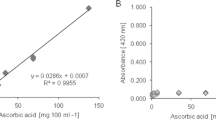Abstract
Açai (Euterpe oleracea) is a palm plant that is native to South America and produces deep purple berry fruits. Despite açai’s popularity as a dietary supplement, little is known about the phenolic composition and antioxidant properties of commercially available açai berry products. Therefore, twenty açai supplements in a variety of forms (e.g., capsule, powder, frozen pulp, and liquid) were analyzed for their total phenolic and anthocyanin contents, individual anthocyanin and other flavonoid concentrations, and antioxidant capacities. Hierarchical cluster analysis was then used to group açai supplements into categories based on similarities in their chemical profiles and antioxidant properties. Results showed that over half of the supplements contained little or no açai fruit or had sufficient amounts of water to substantially lower the concentration of açai chemical components. Additionally, two açai supplements contained unlisted ingredients that greatly altered the products’ chemical properties. Chromatographic analysis of individual anthocyanins and other flavonoids was useful in identifying the presence of açai fruit within the dietary supplements while complimentary in vitro spectroscopic assays aided in detection of adulterants. This study highlights the complexity of the dietary supplement market while also showing the importance of collectively analyzing data from multiple complimentary techniques when evaluating açai berry products.



Similar content being viewed by others
References
Weinstein S, Moegenburg S (2004) Açaí palm management in the Amazon estuary: course for conservation or passage to plantations? Conserv Soc 2:315–346
Heinrich M, Dhanji T, Casselman I (2011) Açai (Euterpe oleracea Mart.) – a phytochemical and pharmacological assessment of the species’ health claims. Phytochem Lett 4:10–21
Schreckinger ME, Lotton J, Lila M, de Mejia EG (2010) Berries from South America: a comprehensive review on chemistry, health potential, and commercialization. J Med Food 13:233–246
Benatrehina PA, Pan L, Naman CB, Li J, Kinghorn AD (2018) The use, biological activity and safety of selected botanical dietary supplements consumed in the United States. J Tradit Complement Med 8:267–277
Yamaguchi KKL, Pereira LFR, Lamarão CV, Lima ES, da Veiga-Junior VF (2015) Amazon acai: chemistry and biological activities: a review. Food Chem 179:137–151
Odendaal AY, Schauss AG (2014) Potent antioxidant and anti-inflammatory flavonoids in the nutrient-rich Amazonian palm fruit, açai (Euterpe spp.). In: Watson RR, Preedy VR, Zibadi S (eds) Polyphenols in human health and disease, vol 1. Elsevier Inc, Amsterdam, pp 219–239
Lichtenthäler R, Rodrigues RB, Maia JGS, Papagiannopoulos M, Fabricus MF (2005) Total oxidant scavenging capacities of Euterpe oleracea Mart. (açaí) fruits. Int J Food Sci Nutr 56:53–64
Schauss AG, Wu X, Prior RL, Ou B, Patel D, Huang D, Kababick JP (2006) Phytochemical and nutrient composition of the freeze-dried Amazonian palm berry, Euterpe oleraceae Mart. (acai). J Agric Food Chem 54:8598–8603
Zafra-Stone S, Yasmin T, Bagchi M, Chatterjee A, Vinson JA, Bagchi D (2007) Berry anthocyanins as novel antioxidants in human health and disease prevention. Mol Nutr Food Res 51:675–683
Gordon A, Cruz APG, Cabral LMC, de Freitas SC, Taxi CMAD, Donangelo CM, de Andrade Mattietto R, Friedrich M, da Matta VM, Marx F (2012) Chemical characterization and evaluation of antioxidant properties of açai fruits (Euterpe oleraceae Mart.) during ripening. Food Chem 133:256–263
Pacheco-Palencia LA, Duncan CE, Talcott ST (2009) Phytochemical composition and thermal stability of two commercial açai species, Euterpe oleracea and Euterpe precatoria. Food Chem 115:1199–1205
Fibigr J, Šatínsky D, Solich P (2018) Current trends in the analysis and quality control of food supplements based on plant extracts. Anal Chim Acta 1036:1–15
Lee J (2014) Marketplace analysis demonstrates quality control standards needed for black raspberry dietary supplements. Plant Foods Hum Nutr 69:161–167
Henning SM, Zhang Y, Rontoyanni VG, Huang J, Lee RP, Trang A, Nuernberger G, Heber D (2014) Variability in the antioxidant activity of dietary supplements from pomegranate, milk thistle, green tea, grape seed, goji and acai: effect of in vitro digestion. J Agric Food Chem 62:4313–4321
Mulabagal V, Keller WJ, Calderón AI (2012) Quantitative analysis of anthocyanins in Euterpe oleracea (açaí) dietary supplement raw materials and capsules by Q-TOF liquid chromatography/mass spectrometry. Pharm Biol 50:1289–1296
Wu X, Gu L, Prior RL, McKay S (2004) Characterization of anthocyanins and proanthocyanidins in some cultivars of Ribes, Aronia, and Sambucus and their antioxidant capacity. J Agric Food Chem 52:7846–7856
Singleton VL, Rossi JA Jr (1965) Colorimetry of total phenolics with phosphomolybdic–phosphotungstic acid reagents. Am J Enol Vitic 16:144–158
Abdel-Aal ESM, Huel P (1999) A rapid method for quantifying total anthocyanins in blue aleurone and purple pericarp wheats. Cereal Chem 76:350–354
Lee J, Durst RW, Wrolstad RE (2005) Determination of total monomeric anthocyanin pigment content of fruit juices, beverages, natural colorants, and wines by the pH differential method: collaborative study. J AOAC Int 88:1269–1278
Benzie IFF, Strain JJ (1996) The ferric reducing ability of plasma (FRAP) as a measure of “antioxidant power”: the FRAP assay. Anal Biochem 239:70–76
Cheng Z, Moore J, Yu L (2006) High-throughput relative DPPH radical scavenging capacity assay. J Agric Food Chem 54:7429–7436
Apak R, Özyürek M, Güçlü K, Çapanoglu E (2016) Antioxidant activity/capacity measurement. 1. Classification, physicochemical principles, mechanisms, and electron transfer (ET)-based assays. J Agric Food Chem 64:997–1027
Wang SY, Chen C-T, Sciarappa W, Wang CY, Camp MJ (2008) Fruit quality, antioxidant capacity, and flavonoid content of organically and conventionally grown blueberries. J Agric Food Chem 56:5788–5794
Acknowledgements
This work was supported by the Robert A. Welch Foundation (AF-0005) and Southwestern University’s Herbert and Kate Dishman fund. The authors wish to thank James Alleyn and Anthony Dapoz for their role in initiating this study.
Author information
Authors and Affiliations
Corresponding author
Ethics declarations
Conflict of Interest
The authors declare that they have no conflict of interest.
Additional information
Publisher’s Note
Springer Nature remains neutral with regard to jurisdictional claims in published maps and institutional affiliations.
Electronic Supplementary Material
ESM 1
(DOCX 360 kb)
Rights and permissions
About this article
Cite this article
Earling, M., Beadle, T. & Niemeyer, E.D. Açai Berry (Euterpe oleracea) Dietary Supplements: Variations in Anthocyanin and Flavonoid Concentrations, Phenolic Contents, and Antioxidant Properties. Plant Foods Hum Nutr 74, 421–429 (2019). https://doi.org/10.1007/s11130-019-00755-5
Published:
Issue Date:
DOI: https://doi.org/10.1007/s11130-019-00755-5




